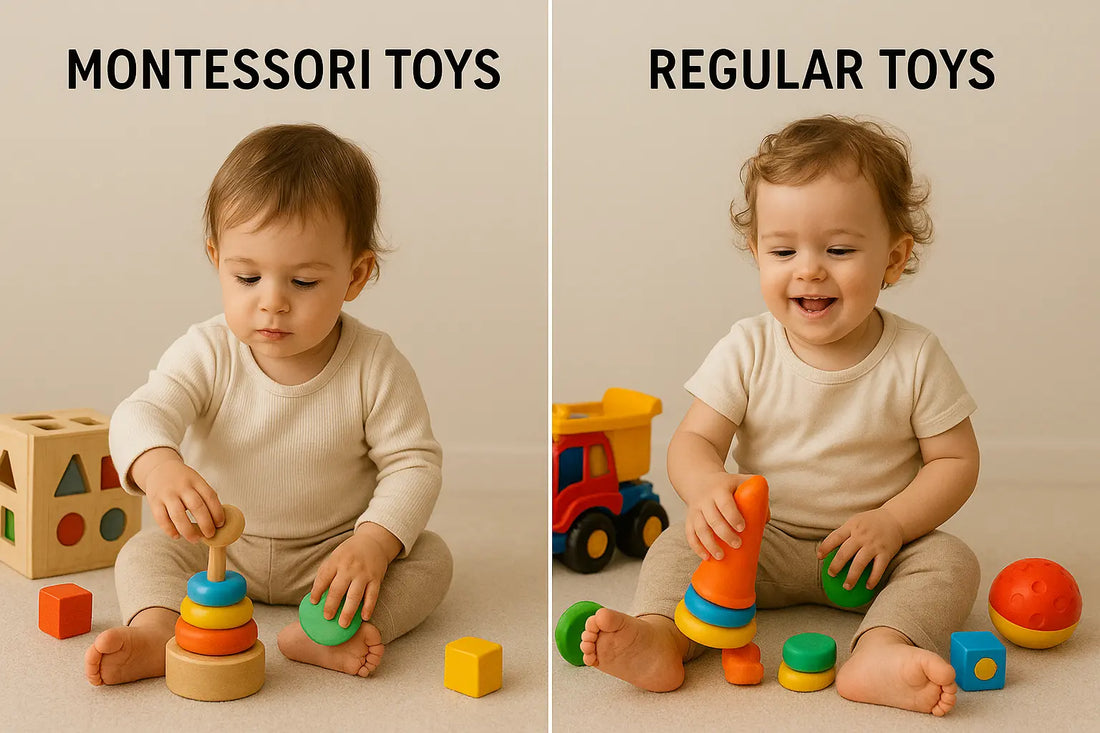
Montessori Toys vs. Regular Toys: What’s Best for Your Child’s Development?
Share
Introduction
When it comes to choosing toys for your little one, the options can feel overwhelming. Parents often hear about Montessori toys and wonder: Are they really better than regular toys? The truth is, the right toys play a big role in shaping your child’s early learning journey. In this blog, we’ll explore the differences between Montessori toys and regular toys, their benefits, and how you can make the best choice for your child’s growth.
Understanding Montessori Toys for Toddlers
Montessori toys are designed to encourage independent learning, problem-solving, and hands-on exploration. They are usually simple, made with natural materials, and focus on one skill at a time.
✨ Examples:
- Número – The Counting Caterpillar (teaches math concepts through play)
- Rainbow Popsicle Colour Matching Game (colour sorting and fine motor development)
- Snap ‘n’ Link Fun Strips (creativity and hand-eye coordination)
These toys align with the Montessori principle: “Help me do it myself.”
Regular Toys: Pros and Cons
Regular toys, often battery-operated or flashy, are designed for entertainment. They may sing, light up, or move on their own, which can grab your child’s attention but sometimes limit active engagement.
👍 Pros of regular toys:
- Fun and entertaining.
- Keep children busy for a short time.
👎 Cons of regular toys:
- Can overstimulate (lights, sounds).
- Encourage passive play.
- Often made of plastic with limited learning value.
Montessori Toys vs. Regular Toys: Key Differences
- Active vs. Passive Play – Montessori toys encourage the child to think and act, while regular toys often “do the work” for them.
- Skill Building vs. Entertainment – Montessori toys target real-life skills like sorting, counting, and problem-solving.
- Natural vs. Plastic – Montessori toys are usually made of safe, natural, or tactile materials.
- Focus vs. Distraction – Montessori toys present one learning challenge at a time, while flashy toys can scatter focus.
Why Montessori Toys Are Better for Development
Research shows that hands-on play enhances brain development in early years. Montessori toys support:
- Cognitive skills (math, language, problem-solving)
- Fine motor skills (grasping, sorting, linking)
- Focus & independence (self-paced learning)
By contrast, regular toys often provide quick excitement but less long-term educational value.
GiGeeGaGaa’s Montessori-Inspired Toy Picks
-
Número – The Counting Caterpillar
Helps toddlers learn numbers, sequencing, and colours through playful counting. -
Rainbow Popsicle Color Matching Game
Builds colour recognition and early sorting skills. -
Snap ’n’ Link Fun Strips
Boosts creativity, logical thinking, and fine motor control. -
3D Wild Animal Flashcards
Supports early literacy and vocabulary building with interactive 3D learning.
FAQs About Montessori Toys
Q1: At what age should I introduce Montessori toys?
Montessori toys can be introduced as early as infancy, starting with simple sensory objects.
Q2: Are Montessori toys expensive?
Not always! Many Montessori-inspired toys are affordable, durable, and grow with your child.
Q3: Can I mix Montessori toys with regular toys?
Yes. A balance is possible, but Montessori toys should form the foundation for daily play.
Conclusion
When it comes to Montessori toys vs. regular toys, the difference is clear: Montessori toys help children learn, explore, and grow, while regular toys often entertain in the short term. By choosing toys that encourage independence and problem-solving, you’re giving your child a strong foundation for lifelong learning.
✨ Explore GiGeeGaGaa’s educational toy collection to start building your child’s Montessori play corner today!
